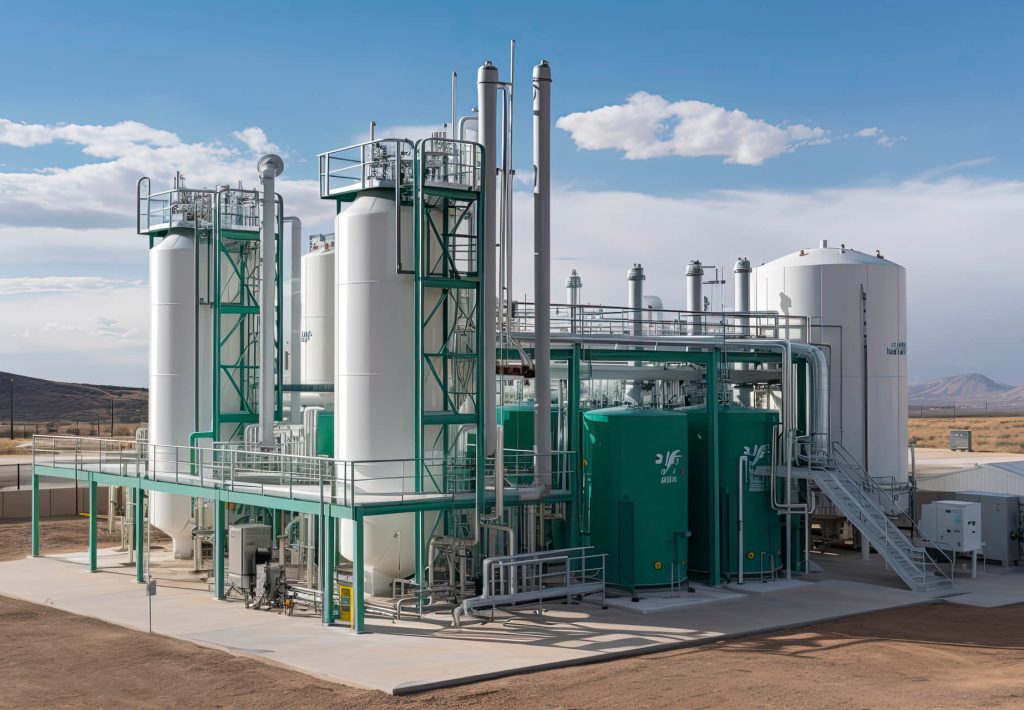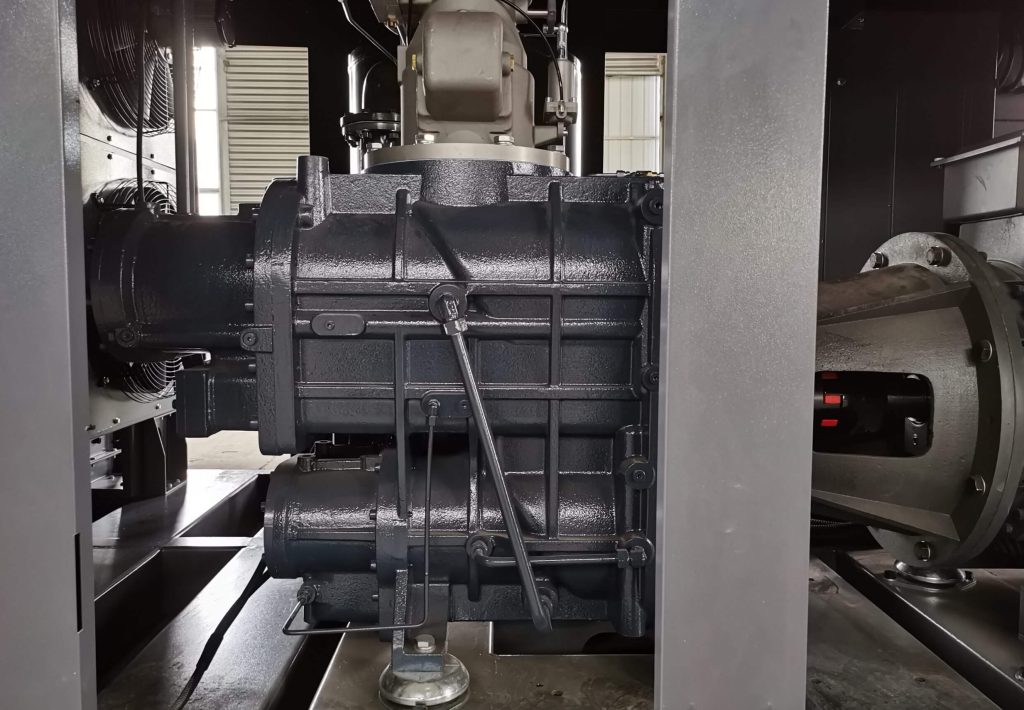As a typical compressor device, screw air compressors are widely used in industrial fields requiring continuous air supply, such as manufacturing, mining, and construction. This article provides a detailed introduction to screw air compressors, focusing on their technical definition, working principle, core advantages, and practical applications.
A screw air compressor is an industrial device that compresses gas through the meshing and rotating of male and female rotors. Its core components are precisely machined spiral rotors. By changing the volume, the screw air compressor compresses atmospheric air to the target pressure, providing a stable air source. Compared to piston compressors, screw air compressors have higher energy efficiency and lower maintenance costs, making them suitable for industrial scenarios requiring continuous air supply. The main advantages of screw air compressors include high efficiency, low noise operation, and long maintenance intervals, making them widely used across various industries.

1. Technical Definition of Screw Air Compressor
A screw air compressor is an industrial-grade device that achieves gas compression through the meshing and rotation of male and female rotors. Its core components are a pair of precision-machined spiral rotors (male rotor and female rotor), which compress atmospheric air to the target pressure (0.7–1.3 MPa) by changing the volume, providing a stable air source for industrial production.
Core Value:
- High Efficiency and Energy Saving: Compression efficiency is 30–50% higher than piston air compressors.
- Low Maintenance Cost: No wear parts design; major overhaul cycles can reach 40,000–80,000 hours.
- Low Noise Operation: Noise levels as low as 75 dB(A), suitable for precision manufacturing workshops.
2. Working Principle: 4-Step Dual-Rotor Compression Process
- Suction Phase: As the rotors rotate, the tooth groove space connects with the intake port, drawing in atmospheric air and sealing it within the rotor chamber.
- Compression Phase: The rotors continue to rotate, and the tooth groove space gradually decreases. Gas is compressed and mixed with lubricating oil, forming an oil film to seal gaps.
- Exhaust Phase: Once the compressed gas reaches the set pressure, it is expelled through the exhaust valve into a storage tank or gas pipeline.
- Circulation Phase: Lubricating oil is filtered by the oil-gas separator and reused, ensuring long-term stable system operation.
Technical Comparison:
| Type | Screw Compressor | Piston Compressor |
| Energy Efficiency | High (IPLV>8.0) | Low (IPLV≈5.5) |
| Maintenance Cost | Low (No valve wear) | High (Many wear parts) |
| Applicable Scenarios | Continuous air supply | Intermittent air supply |
3. 6 Core Advantages of Screw Air Compressors
3.1 Energy-Saving Technological Breakthroughs
- Permanent Magnet Inverter Technology: Dynamic speed adjustment via vector control algorithms saves up to 40% energy.
- Heat Recovery System: Waste heat from compression preheats process water, improving overall energy efficiency by 15%.
3.2 Intelligent Control
- IoT Remote Monitoring: Real-time tracking of pressure, temperature, and energy consumption with fault warning systems.
- Adaptive Adjustment: Automatically adjusts load according to air demand, eliminating idle waste.
3.3 Modular Design
- Skid-Mounted Integration: Combines compressors, dryers, and storage tanks, saving 50% floor space.
4. Industry Application Scenarios and MINNUO Solutions
4.1 North American Automotive Manufacturing: Detroit Parts Factory
- Requirement: Stable air source for smart production lines to ensure 24-hour operation.
- Solution: Deployed MINNUO M series permanent magnet inverter screw compressor (50HP), achieving 99.9% nitrogen purity and annual electricity savings of ~17,000 (calculated at 0.12/kWh).
4.2 European Food Group: Amsterdam Sterile Production Line
- Requirement: Oil-free compressed air meeting EU food-grade standards (EC 1935/2004).
- Solution: MINNUO W series oil-free screw compressors with stainless steel main units and three-stage filtration, certified by BRC, reducing annual maintenance costs by 60%.
4.3 Southeast Asian Environmental Project: Jakarta Waste-to-Energy Plant
- Case: Installed two MINNUO LS200D-8W units (250HP), processing 600 tons of waste daily, achieving 28% energy savings and reducing carbon emissions by ~3,000 tons annually (UN Green Technology certified).
4.4 Middle East Mining: Saudi Arabian Underground Mining Project
- Solution: Custom explosion-proof screw compressors (ATEX certified), designed for 50°C high temperatures and high-dust environments, reducing annual operating costs per unit by $42,000 compared to traditional models.
5. Key Selection Parameters and Maintenance Guidelines
5.1 Technical Parameters
- Exhaust Capacity: 5–300 m³/min (select 1.5x air demand peak value).
- Working Pressure: 0.7–1.3 MPa (high-pressure models up to 3.0 MPa).
- Oil Content: ≤3 ppm (food-grade requirement: <0.01 ppm).
5.2 Maintenance Points
- Daily Inspections: Check oil level, exhaust temperature (≤95°C), and filter differential pressure.
- Periodic Maintenance:
- Replace lubricating oil and filters (air filter, oil filter, oil separator) every 2,000 hours.
- Clean coolers every 3,000 hours to prevent high-temperature alarms.
6. Frequently Asked Questions (FAQ)
- Q1: How often should lubricating oil be replaced?
- A1: Replace after the first 500 hours, then every 2,000 hours (1,500 hours in harsh environments like mining).
- Q2: How to reduce noise?
- A2: Choose inverter models (noise ≤75 dB), install soundproof enclosures, or vibration-damping bases.
- Q3: How much energy does a screw compressor save vs. a piston compressor?
- A3: For a 50HP model running 8,000 hours/year (0.1/kWh), save ~12,000 annually (screw: ~28kW vs. piston: ~45kW).
- Q4: Are oil-free screw compressors suitable for electronics?
- A4: Yes. MINNUO’s oil-free series has <0.01 ppm oil content, meeting chip manufacturing cleanliness standards.
- Q5: How to resolve high-temperature shutdowns?
- A5: Clean cooler fins, check oil levels and temperature control valves, and upgrade cooling fans if needed.
7. MINNUO Industry Cases and Technical Certifications
7.1 Case Study: German Steel Plant (Ruhr Area)
- Retrofit: Replaced old piston units with MINNUO HD series permanent magnet inverter screw compressors (400HP), saving 240,000 kWh/year ($28,800), with a 15-month payback period.
7.2 Case Study: Japanese Pharmaceutical Company (Tokyo)
- Upgrade: Switched to MINNUO oil-free compressors, reducing oil content from 0.8 ppm to <0.01 ppm, certified by Japan’s MHLW and gaining Sony supply chain access.
Certifications:
- ISO 9001:2015 (Quality Management)
- CE/PED (EU Pressure Vessel Directive)
- UL/cUL (North American Safety)
- ASME BPVC (US Pressure Vessel Standard)
- ATEX (EU Explosion-Proof Certification)
8. Conclusion
Screw air compressors, with their high efficiency, stability, and intelligent features, have become core power devices in global industrial fields. MINNUO, an international manufacturer with over 30 years of technical expertise, provides end-to-end services—from selection consultation and customized solutions to lifetime maintenance.






 Email
Email sales:+86 15366749631
sales:+86 15366749631

